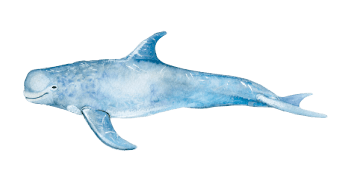
Risso’s dolphin
(Grampus griseus)
These striking animals have a large round head, and – unlike most other oceanic dolphin species – no protruding snout. Their bodies have a light-greygrey base colour which gradually turns paler with scars as they age, particularly around the head area. Some Risso’s dolphin heads are as white as those of beluga whales. Juveniles are olive to brown on the back.Theories behind the origin of these scars range from possible altercations with other members of the species to fights with their main prey, squid.
They are primarily sighted off the coast of Madeira in the summer, mostly in groups of a few up to 30 animals. They can also be seen in the company of or close to other cetaceans, such as Bottlenose dolphins or Pilot whales.
Risso’s dolphins tend to prefer deeper water where they can easily find their prey. Compared to other species, little is known about the social life of Risso’s dolphins due to their timid nature and mysterious habitat.
General information
Further names: Portuguese: Grampo
Size of adults: 2.6 – 3.8 m
Prey: Primarily cephalopods but also fish and crustaceans
Behaviour: These animals are fairly timid in nature but can also be very active on the surface, often spy hopping, breaching or even swimming alongside or in the bow-wave of boats.
Range: The species occurs globally in temperate to tropical waters. They spend most of their time in the deep waters of the open ocean.
Madeira: Occasionally encountered, especially in summer.
Distinctive features: Robust body, usually covered in scratches and scars with a large, relatively high dorsal fin, tilting towards the tail. A clearly visible V-shaped crease can be seen in middle of the forehead. Most of their teeth are in the lower jaw.
Taxonomy: Suborder: Odontoceti (Toothed whales), Family: Delphinidae (Dolphins)
Threats: No data on population size. Like other cetaceans, such as pilot whales, they are still actively hunted (in Japan, Sri Lanka, Philippines, etc.). They often get entangled in nets and drown.
